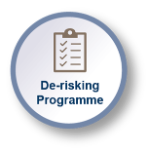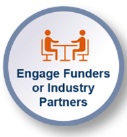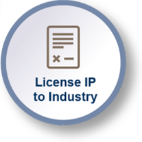Innovation & Enterprise journey
Transferring University intellectual property to an external organisation is a challenging and exciting journey that requires a different and diverse skillset and funding mechanisms to traditional research endeavours.
The University’s IP & Commercialisation team is responsible for working with you to help you at each step of the way, guiding and providing hands-on support throughout the journey.
What can I expect?
During the innovation & enterprise journey, you will encounter many new experiences including jargon, challenges, hurdles, people and funders.
The journey will make many demands on your time. Your first step should be to approach the IP & Commercialisation team for an initial discussion. We will complete an evaluation of your innovation opportunity to verify its ‘scalable impact potential’ and whether it is suited to licensing, a spin-out, or a social enterprise.
We will then form a recommendation to support the opportunity further, including implementation of an intellectual property protection strategy such as a patent filing.
It is possible that our recommendation could be that further research is required or that an innovation & enterprise activity is not the most appropriate route to impact for your innovation opportunity. In these circumstances we will introduce you to other support functions within the University that can help you.
What do we mean by ‘scalable impact potential’?
The term ‘scalable impact potential’ reflects the fact that to pursue an innovation & enterprise activity, an innovation must address an unmet need in the market, in a way that a third party can justify the risk it would take to invest in developing it further into a solution that is ready to be used by consumers and end-users.
When assessing scalable impact potential, we don’t only look for a financial return to the University. The type of impact factors to be considered include the potential for the innovation to create or protect jobs, change a country’s population health outcomes, improve wellbeing through new policies being implemented, or contribute elsewhere towards the delivery of one or more of the United Nation’s Sustainable Development Goals.
What’s involved in evaluating and developing an innovation opportunity?
The IP & Commercialisation team will work with you to evaluate the scalable impact potential of your innovation. This activity will comprise a range of activities including verifying your innovation could meet a significant unmet need in a market or address a global problem, how developed your innovation is, what technical and commercial de-risking is required, the intellectual property that exists in your innovation and how to protect it, its market potential, the competitive solutions that are already available on the market, and possible pathways to deliver impact from the innovation.
This evaluation process will include engagement with external organisations and advisers. On completion of the evaluation process, if a project is selected the IP & Commercialisation team will work with you to protect your innovation, de-risk your innovation and work towards the agreed route to impact whether by securing a licensee or creating a new venture (a spin-out company or a social enterprise).
Securing a licence deal or forming a new company (spin-out or social enterprise) usually requires an innovation opportunity to reach a minimum technical and commercial maturity level. Achieving the required maturity level is called the ‘de-risking’ stage, and varies depending on the type of innovator, its sector, and the intended impact route (licensing or new company). It is important to understand early what minimum technical and maturity level applies to your innovation opportunity.
Many companies and investors use scales such as Technology Readiness Level (TRL) or to assess the maturity of an innovation. These criteria originate from the TRL scales developed by NASA during the 1970’s. However, the principle behind TRLs can be applied to innovation opportunities from all disciplines.
The figure below describes how the TRL scale can be used to assess where an innovation opportunity is along the development journey, and how to get it from basic research (TRL1-TRL3) to an innovation opportunity prototype that is ready for licensing or investment (TRL5-6), all the way to market launch and commercialisation (TRL7-TRL9). Other organisations that have adopted TRLs include the version used by the US National Institutes of Health (NIH) for the life sciences.

What is involved in the innovation & enterprise journey, and how to start?
The innovation & enterprise journey starts with you discussing your innovation opportunity with a member of the IP & Commercialisation team. We strongly recommend that you do this prior to any public disclosure. You can contact a member of the IP & Commercialisation team directly or complete the Opportunity Disclosure Form.
From initial contact, the IP & Commercialisation team will support you through a series of steps to evaluate your opportunity, define a de-risking program and negotiate terms with external parties when appropriate. This journey is illustrated below:

What you can expect at each stage in the innovation & enterprise journey is described below:
| Stage |
Activity |
|
|
The first stage in the innovation & enterprise journey is to discuss your innovation opportunity internally. On disclosing an innovation to the IP & Commercialisation team, they will undertake a high-level assessment of scalable impact potential including diligence to confirm the University has the legal rights to exploit your innovation. Consideration of what intellectual property protection is possible is included in this work. |
|
|
If the initial disclosure review is positive then a more detailed analysis of the scope, scale, and potential for your opportunity is undertaken. This activity determining the tasks (technical and commercial) that are required to be undertaken to either attract licensees, investors or social enterprise funders depending on the pathway chosen. As part of this review, we may consult external organisations and sector experts. |
|
|
Once an innovation opportunity has been triaged and selected, the next stage is to de-risk it. The activities in this de-risking stage will depend on the nature of the opportunity, the technical and commercial maturity required and chosen external route to impact. Examples include:
The funding required for these activities varies by opportunity. Both internal and external grants will be needed. This phase can take 3 to 7 years from initial disclosure. |
|
|
Once de-risking activities are completed, or in parallel, the next stage is to start identifying and engaging with third parties who will help to transfer the intellectual property out of the University, such as potential licensees or spin-out/social enterprise funders and investors. This stage will involve creating non-confidential marketing material about the innovation or company, before reaching out to potential licensees, funders, and/or investors. |
|
|
It is the aim of the previous stages in the innovation & enterprise journey is to reach a negotiation of terms with a third party who will then develop and deliver the impact. The IP & Commercialisation team leads the negotiation of the terms of any transfer of University intellectual property including licence agreements, corporate agreements for new ventures and any other agreements required. They are supported by the Contracts Team and the University’s external lawyers. |
|
|
An outcome of the de-risking and negotiation phases is the creation of a spin-out company or social enterprise (typically not-for-profit). You will have a personal ownership interest in the venture created, but you may also hold other roles such as Director or be involved in the company’s operations. The University will also have an ownership interest which will be managed via a subsidiary company called GU Holdings Ltd. GU Holdings may or may not have a nominee Director on the Board of the venture. |
|
|
Another outcome of the de-risking phase is a licence agreement with an existing organisation. These agreements grant rights to third parties to develop and deliver impact from your innovation. In return the licensee will have legal obligations including financial, progress reporting and sharing of information for REF. |
How are triage and de-risking activities funded?
Innovation & enterprise activities are funded from a variety of internal and external sources. Intellectual property protection costs (including patenting) and legal costs are funded by the University.
The funding required for triage and de-risking innovations varies depending on the opportunity in question and the activities required. For example, drug discovery opportunities that require clinical trials may need anywhere from £0.5m to £2m, whereas a software opportunity may only need £50k for de-risking activities.
The main source of internal de-risking funding is the UKRI Impact Acceleration Accounts. These can provide up to £100k per grant and are managed by Colleges as follows AHRC (Arts); ESRC (Social Sciences) MRC, BBSRC (MVLS) and EPSRC, STFC (Science & Engineering). The other internal fund is the Glasgow Knowledge Exchange Fund (GKEF) and this can make awards of up to £30k.
There are many external grant programmes and relevance will depend on the opportunity. For example, the Scottish Enterprise High Growth Spin-Out Programme (up to £750k) supports de-risking to create high growth ventures in Scotland; the British Heart Foundation Translational Award (up to £750k) supports de-risking cardiovascular disease treatment opportunities for take-up by industry or investors; and, the Medical Research Council DPFS scheme (up to £3m) to de-risk therapeutic and medical device treatments to industry or investor engagement. For post-doctoral researchers and early-career innovators, there are schemes such as the Innovate ICURe programme and Enterprise Fellowships that provide funding to allow you the time to evaluate and develop your innovation. The IP & Commercialisation team will help you to identify the most suitable funding programme for your opportunity.








